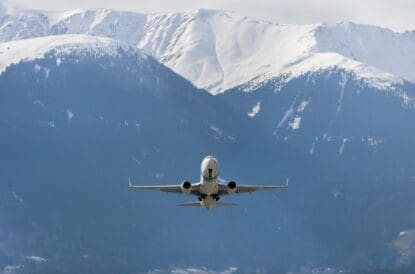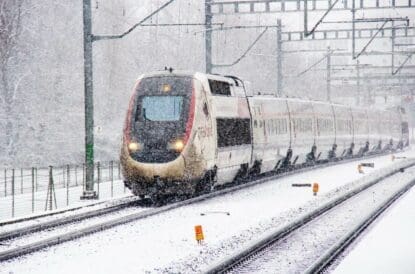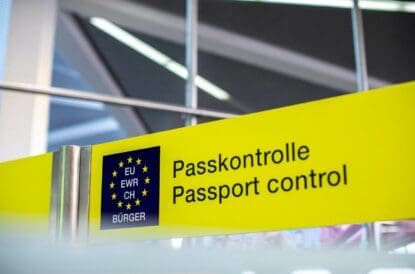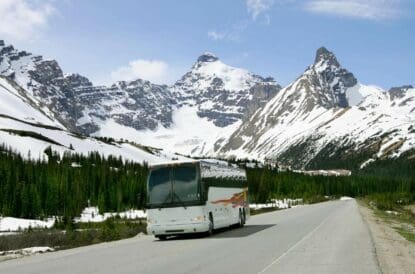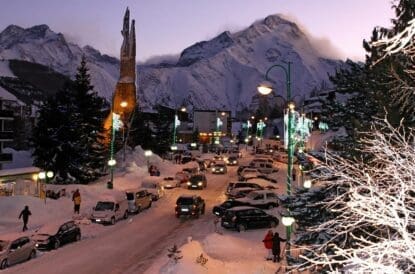Driving to a ski resort can be a great alternative to flying if journey time isn’t a factor. If you’ve never driven to the Alps before, the trip can seem a little daunting, but with a few helpful tips and expert advice you can get on the road to the ski resorts in no time. With no expensive transfers, no luggage restrictions and the freedom to take it at your own pace, driving can be a great option for getting to the snow. It’s also good if you plan to travel between different ski areas whilst you’re away, or to save some money by staying in accommodation a bit further down the mountain and driving to your chosen ski area each day.
Crossing the Channel
Eurotunnel
Le Shuttle is the quickest way to get your car to the continent – the crossing takes just 35 minutes and you’re closer to the motorway when you arrive in France so you can get on your way quicker too. It is generally more expensive than the ferry though. The Eurotunnel terminal is near Folkestone – junction 11A on the M20.
More details and online booking at eurotunnel.com.
Catching the Ferry
Taking your car on the ferry is usually the most economical way to get to the continent. The quickest and most popular route is Dover to Calais but there are several other routes you could consider depending on your UK starting point. These include: Folkestone to Calais, Portsmouth to Caen, Le Havre, St Malo or Cherbourg, Plymouth to Roscoff, Dover to Boulogne or Dunkirk, Newhaven to Dieppe, and Poole to Cherbourg or St Malo. If you are further north and want to save driving through England you can also go from Hull to Zeebrugge in Belgium or Rotterdam in the Netherlands or from Newcastle to Amsterdam. These ferries tend to be overnight and once you arrive it is best to head towards the German Autobahn. Alternatively from Dusseldorf you can put your car on an OBB sleeper train all the way to Innsbruck which takes around 12 hours and is usually a fairly reasonable price, details here – OBB.
You can book directly with the main ferry operators – DFDS Seaways, Brittany Ferries, P&O Ferries.
Winter Driving
There are plenty of things to consider about driving to resort in winter, and it’s worth taking some time to plan your journey in advance. Here are a few of our top tips:
- Snow chains – practice putting them on before you go, and also check them after driving 10 metres once they’re on, they go on the wheels with drive, so check if your car is front, rear or 4WD.
- Check overseas regulations for driving abroad.
- Arrange overseas breakdown cover and insurance.
- Buses use both parts of the road on hairpin bends – always look ahead.
Driving in Snow
- Always keep a good distance between you and the vehicle in front.
- Keep your speed down and brake gently to avoid skidding.
- Stay in a high gear in icy or snowy conditions.
- It is the law to keep your headlights on in falling snow, make sure they are cleared of snow and remain clean.
- If your car gets stuck in the snow, try rocking the car by engaging a high gear and then reverse.
- It is compulsory to carry snow chains on many mountain roads, and in many places you must have winter or 4 season tyres on your vehicle.
- Always carry a spade and some sacking to use for traction.
- Make sure your wipers can cope with the snow on your windscreen.
Keep the washer bottle topped-up and remember to add anti-icing solution.
Avoiding Skidding
- Check tyre pressure and tread.
- Avoid sudden steering, braking and hard acceleration. Gently pump the brakes rather than applying any prolonged pressure – though bear in mind that ABS brakes may behave differently.
- Keep your speed down and anticipate likely road and traffic conditions.
If you do start to skid, take your foot off the accelerator and steer into the skid. Avoid braking if at all possible.
Snow Chains and Tyres
Snow chains normally cost £80 to £150, but they’re also available for hire. You can buy them in various places across the UK.
Most cars have tyres with semi-winter rubber compounds that will work fairly well in light to moderate snow – although sports cars will generally not have suitable tyres fitted. Snow chains and/or tyres are a must when driving in the mountains. If you’re driving to the mountains it’s compulsory to carry approved snow chains in your car or van. If a vehicle is removed in an accident, when it is considered that snow chains should have been used, it is automatically deemed to be the fault of the driver without the chains, regardless of the circumstances.
You should only use snow chains when there is snow on the road. Often there will be signs showing specific areas where chains can be fitted. Always pick a safe place to fit and remove chains, preferably on level ground, make sure you fit them to the correct wheels, they should be on the ones that drive the car, so on the front wheels of most cars, the back wheels of rear wheel drives and ideally on all 4 wheel of a 4wd vehicle. Once they are fitted it’s advisable to drive slowly and take corners as smoothly as possible.
Ski Racks and Boxes
Think ‘outside the car’. Ski equipment can be carried in a ski rack, or better still, a lockable ski box fitted to the roof of the car. A typical rack will take up to four pairs of skis, and some can take up to six pairs, plus poles and several pairs of boots, leaving much more space inside the car for luggage and passengers. Roof boxes are also a great option for carrying extra equipment.
Remember, with your Ski Club membership, you receive a 10% discount with Roof Box Company, the UK’s leading specialist supplier of vehicle load-carrying gear. Please click here to obtain your discount.
Driving in Europe
Paying Tolls
When driving from the UK to a ski resort you’ll have to pay road tolls, so make sure you have Euros and if you’re travelling in Switzerland, Swiss Francs. Toll booths are always on the left-hand side of the car, so if you’re driving a British car and you don’t have a passenger, bear this in mind!
For France, sign up for a Télépéage electronic device which is read as you pass through the toll, ensuring rapid passage through the tolls. Visit www.saneftolling.co.uk.
There are some great websites that can price up how much the tolls will cost you through France – visit www.autoroutes.fr
Tolls are also charged in Switzerland and Austria for driving on their autobahns. You can buy display stickers at the borders and in nearby service stations. In Italy tolls are payable at booths before or after the Autostrada so keep hold of your ticket.
Overseas Regulations
- Documents: take your driving license, vehicle registration document, and certificate of motor insurance. If the vehicle is not registered in your name, carry a letter from the registered owner giving you permission to drive.
- UK-registered vehicles must display “UK” stickers on the rear of the vehicle
- Motorway breakdown visibility vests are now compulsory in most parts of the EU, one for each person travelling in the vehicle.
- Carry a warning triangle – in most countries they are obligatory.
- Speeding and other traffic offences in Europe are subject to on-the-spot fines – many European countries do not advertise speed camera locations, including on Satnav or other mapping software.
- Austria, France and Germany require you to carry a First Aid kit in the vehicle at all times.
- Dipped headlights or daylight running lights are either recommended or compulsory in most alpine countries. Carry spare bulbs for your headlights, indicators and brake lights. If your car allows you to switch headlights from RHD to LHD beam pattern, do so, if not you can buy stick on beam adaptors for driving in Europe.
- Permitted blood alcohol levels for driving in most European countries are LESS than allowed in England (0.8 mg per ml). Scotland, Germany, France, Italy and Austria permit 0.5 mg per ml, Switzerland is 0.8.
There are various regulations for specific countries too, so it’s always worth checking the details for the countries you’re going to passing through. France requires you to carry a breathalyser in your vehicle. Detailed information for each country can be found on the AA website.
Drive Friendly Resorts
The Alpine and Pyrenean mountain ranges are accessible from the channel ports, but arguably the best resorts are in the Western Alps – specifically northern French Alps, north western Italy (Aosta Valley) and Western Swiss Alps. The closest major ski area to drive to is the French/Swiss Portes du Soleil which includes Morzine Avoriaz, Les Gets, Chatel and Champery.
For ski resorts in the rest of Switzerland, Italy and Austria, the best route is to travel further east through Belgium, the Netherlands or Luxembourg and then down through Germany.
Typical journey times are 10-14 hours. The following ‘drive-to friendly’ resorts have a non-stop journey of 9-12 hours depending on traffic and weather conditions. All distances are from Calais. Check the route on Google Maps before you set off for real time traffic, road closures and best routes.
France
- Chatel – 828km
- Morzine – 881km
- Flaine – 882km
- Megeve – 884km
- La Clusaz – 860km
- Les Contamines – 890km
- St Gervais – 890km
- Chamonix – 892km
- Valmorel – 918km
- La Plagne – 930km
- Les Deux Alpes – 933km
- Alpe d’Huez – 934km
- La Grave – 944km
- Les Trois Vallees – 955km
- Les Arcs – 976km
- La Rosiere – 976km
- Sainte Foy – 978km
- Espace Killy – 998km
Italy
- Courmayeur – 911km
- La Thuile – 940km
- Cervinia – 1000km
Switzerland
- Champery – 814km
- Grindelwald – 835km
- Verbier – 850km
- Crans Montana – 876km
- Gstaad – 905km
- Saas Fee– 916km
- Zermatt – 919km
- Les Diablerets – 920km
- Villars – 930km
Austria
- Montafon – 928km
- Warth-Schröcken – 935km
- St Anton – 956km
- Lech-Zürs – 990km
- Ischgl – 1000km
- Galtür – 1009km
Germany
- Garmisch Partenkirchen – 1008km
Closest resorts to Calais (but not major ski areas)
- Willingen (Black Forest, Germany) – 536km
- Gerardmer (Voges, France) – 568km
- Le Noirmont/Mijoux (Jura, France) – 706km
Summary
When driving to the Alps, try to remember the following points:
- Use luggage racks to store skis, otherwise they take up a lot of space!
- Check regulations for driving in any countries you pass through
- Make sure your insurance covers you for driving abroad
- Driving in snow can be challenging; plan ahead by making sure you have all appropriate kit, and practice putting on snow chains before you need them

